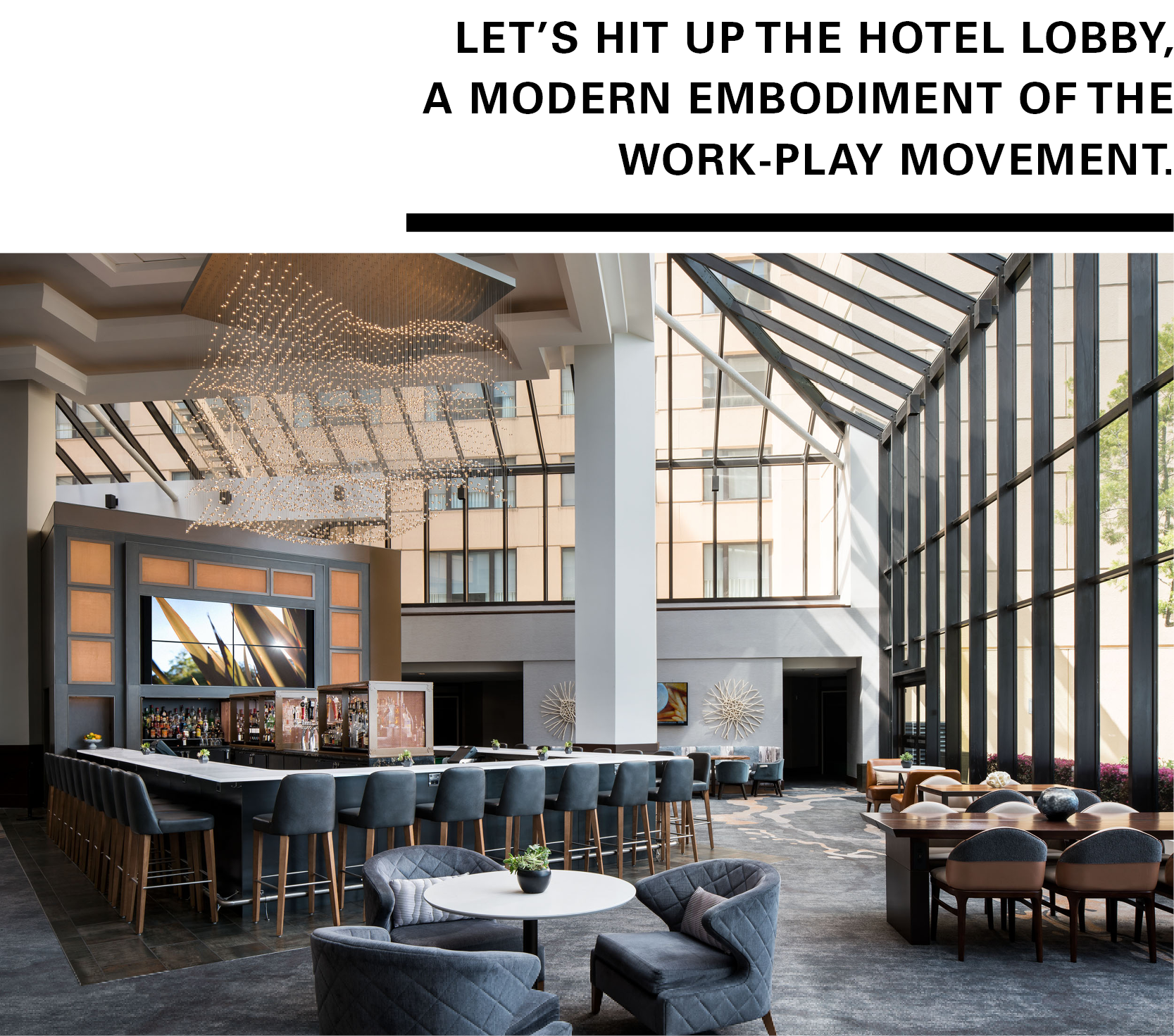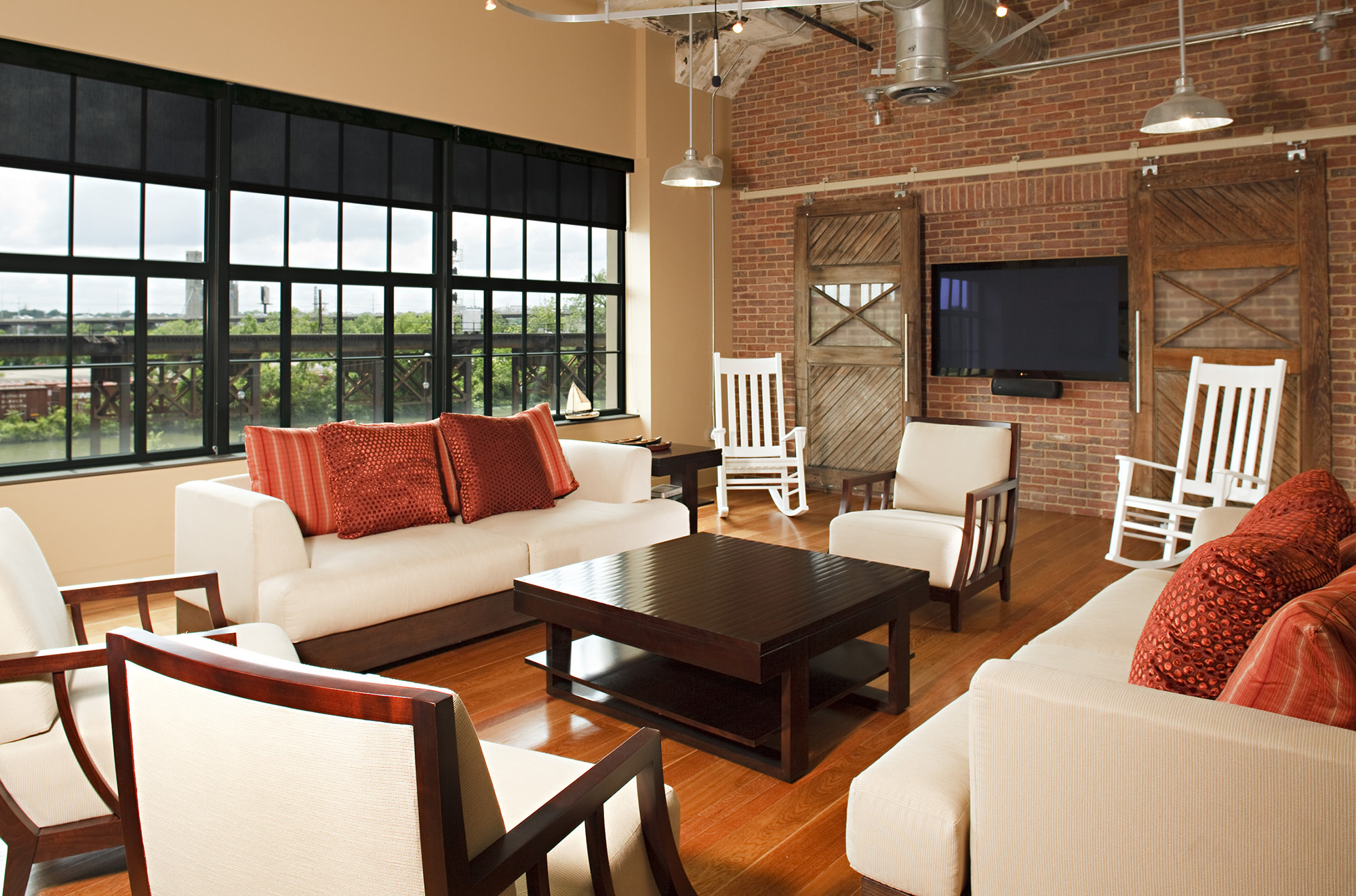Since we’re at the forefront of redefining workplace strategy in today’s golden era of office reinvention, we know you need more than a pretty space—you need an office that delivers big results. That’s why we’re unpacking the trends and insights we’ve uncovered in a series on better workspaces. Miss the first installment? Click here to get caught up.
In the not-so distant past, road warriors—the most hardcore of business travelers—endured run-of-the-mill hotels with simple amenities: the standard coffee pot, an iron, a mini-fridge, some travel-size toiletries, and maybe a small business center. Hotelier’s had not yet recognized their properties could be more; hotels were just the place people stayed to get to where they actually wanted to go, not destinations in and of themselves—not yet.
That’s when everything changed, says Matthew Marsili, associate and interior designer director.

They failed to meet the needs of all road warriors, because there are numerous sub-sets of travelers—each with preferences for how they relax, how they conduct business, and how they want to interact with other people.
Soon, hotel lobbies and public spaces transformed. Static check-in desks were traded in for café/bar combos, with staff trained to greet a guest and serve them a drink. Sad, tired business centers were swapped out for communal tables right in the thick of the action, and guests were empowered to move around the hotel with new avenues and amenities to customize their stay. The experience became less about connecting with hotel staff and more about connecting with other guests. And the more they got used to these interactive experiential spaces while traveling, the more they wanted choices and similar flexibility back at the office.

Case in point: Hyatt’s new headquarters, which artfully mimics the feel and function of its hotels. Modeled after the brand’s seven guest experience touchpoints (arrival, social spaces, drinking and dining, guest rooms/work suites, activities and services, meetings and events, departure), the workspace embraces the best of both hospitality and workspace design elements.
It isn’t a coincidence that, after years of working in our hospitality studio, Matthew now helps lead our workspace interiors team. With an intuitive sense for designing highly collaborative shared spaces—lounges, restaurants, museums—he believes businesses should look to how hotels design and curate the guest experience, because the hospitality industry has long understood a surprisingly simple concept:

“Our needs don’t change because we’re on a business trip or we’re at work,” Matthew says. We still need the basics: food, water, rest, shelter. Beyond that, humans also have emotional needs: security, fulfillment, and purpose. The hospitality industry is skilled at unlocking and tapping into emotional undercurrents to really emphasize how design can support those higher needs.
And workspaces are following suit. Or rather, they’re ditching the suits in favor of cultures that instead promote innovation, creativity, and flexibility—opting for an office environment that focuses more on the people doing the work.

Meant to buzz with activity at all hours, lobbies are packed with informal seating areas, bars, cafes, and more. People cluster, working on laptops at communal tables or mingling at the bar. When you walk in the front doors of a hotel, you’re walking into that hotel brand’s essence—and the community it has created.
Now think about a traditional company entrance. You walk in, immediately stopped by a receptionist’s desk in front of a wall that blocks you from the rest of the office. It’s a static experience that creates not just a literal barrier but a metaphorical barrier between the people in your workspace and the identity of your company.
By physically opening up your first impression, you’re opening up so much more. “It’s transparent and authentic,” says Matthew. “You’re not creating a different experience for a client versus an employee; you’re just creating one experience within the space that embodies the overall brand.”

Understanding your individual company’s culture and identity is a key step in designing the space, and that’s another page lifted from the hospitality design playbook. There’s a reason why there aren’t only three hotel brands in the world. It’s because there are so many different types of people, and each brand aims to cater to very specific markets, capturing the personality of that guest and giving them the experience they crave.
How do they do it? Data. Lots and lots of data, says Principal Bob Tierney, our hospitality studio’s director of design. “It’s very much an analytical industry,” he says. “Each flag knows their audience precisely because they’ve been tracking the data for years. The goal is to have our designs be a clear snapshot of that flag’s identity and guest persona.”
And yes, companies are starting to play the data game, too: using sensors to track how much time people spend at their desks, when (and for how long) conference rooms are used, and the typical routes people take while walking throughout the office. It’s a strategy our team has been exploring in our own office, and in tandem with qualitative research and analysis, these kinds of tools help workspace strategists streamline efficiencies, improve adjacencies, and ultimately, design an office that embodies a company’s culture and core values.

“This is a generation of talent that has been wooed and recruited their entire lives,” says Matthew—just think about today’s university campus experience. “They’re used to interactive, flexible villages of amenity and choice. Everything they want or need, they can find on campus. So imagine what they’re expecting out of the workplace.”
A pivotal moment for hoteliers was realizing they didn’t fully understand their guests. To embrace the nuances of their audiences—who they were and what they needed—it took investments in time and in research, and it required bringing on new partners who were able to shake up misconceptions, make sense of the data, and design experiential destinations that cater to human needs, both physiological and aspirational. With the right workspace strategists as a partner, companies can offer the same, tapping into the unrealized potential of their offices—and unlocking the full potential of their employees.
A workspace warm-up is underway, boosting productivity and collaboration. Want to know the driving design principle behind the significant shift? All that (and more) is up next in our “Design Better Work” series.


